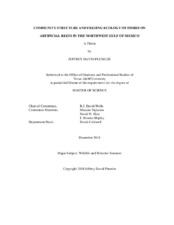| dc.description.abstract | Artificial reefs serve as important habitat for several marine fish species in the northwest
Gulf of Mexico (NW GoM). Structure type, relief, and depth of artificial reefs have been
shown to affect the community composition and trophic relationships of reef associated
fishes. The purpose of this study is to investigate these relationships using a variety of
metrics examining both fish assemblage and trophic ecology on several nearshore
artificial reefs in the northwest Gulf of Mexico. Chapter I uses a suite of traditional
fisheries methods to observe the effects of individual structure on the assemblage of
marine fish. We investigated three individual reef types (concrete, rig, and ship) using
three survey methods (fish trap, vertical longline, and active acoustics) over four years of
sampling (2014 -2017). Two reef types, rig and ship, were found to have a more diverse
assemblage of fish than concrete reefs using traditional fishing methods (vertical
longline and fish trap); however, concrete reefs were found to have higher
concentrations of fish using active acoustics. These results indicate that increased reef
relief and complexity offer habitat for a wider range of species, while low relief habitats
attract less diverse assemblages of fish in higher concentrations. The differences in
trophic structure were also investigated on high and low relief structure types in Chapter
II. Using both stable isotope and fatty acid analyses we examined the feeding ecology of
three reef associated fishes, tomtate (Haemulon aurolineatum), pigfish (Orthopristis
chrysoptera), and red snapper (Lutjanus campechanus). The three species were
compared on high relief habitats, while one species, red snapper, was also investigated
on low relief habitats. The three species exhibited different feeding strategies using
stable isotope values and fatty acid ratios that reflected known diets from other regions.
Red snapper feeding ecology was different between the two structure types. Red snapper
that were collected on low relief habitats fed on a higher trophic level than those
collected on high relief habitat types. This difference among the structure types may be
due to the lack of intraguild competition that may occur on more diverse high relief reefs
relative to less diverse low relief reefs. Overall results suggest that artificial reef
structure type and design may support unique assemblages and provide different
functions to reef associated species. | en |


